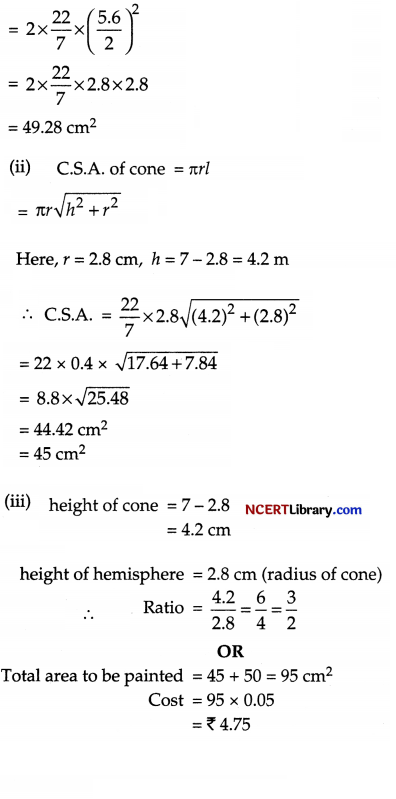Practicing the CBSE Sample Papers for Class 10 Maths Standard Set 4 allows you to get rid of exam fear and be confident to appear for the exam.
CBSE Sample Papers for Class 10 Maths Standard Set 4 with Solutions
Section – A
Question 1.
Find the roots of the quadratic equation x2 + 14x + 40 = 0:
(a) – 10,- 4
(b) 10,- 4
(c) -10, 4
(d) 10, 4
Answer:
(a) -10, – 4
Explanation: Given, x2 + 14x + 40 = 0
⇒ x2 + 14x + 4x – 40 = 0
⇒ x(x + 10) + 4(x + 10) =0
⇒ (x + 10)(x + 4) = 0
⇒ x + 10 = 0 or x + 4 = 0
⇒ x = -10 or x = – 4
Hence, roots of equation are – 10, – 4.
Question 2.
In the given figure, △ABC ~ △PQR, find the measure of ∠C:
(a) 80°
(b) 40°
(c) 80°
(d) None of these

Answer:
(b) 40°
Explanation: Since, △ABC ~ △PQR
∠A = ∠P = 80°
⇒ ∠B = ∠Q = 60°
∠C = ∠R
By angle sum property, we have
∠A + ∠B + ∠C = 180°
⇒ 60° + 80° + ∠C = 180°
⇒ 140° + ∠C = 180°
⇒ ∠C = 180° – 140°
⇒ ∠C = 40“
![]()
Question 3.
Find the 25th term of the A.P. – 5, \(\frac { -5 }{ 2 }\), 0 , \(\frac { 5 }{ 2 }\), …..:
(a) 5
(b) \(\frac { 15 }{ 2 }\)
(c) 55
(d) – 5
Answer:
(c) 55
Explanation: Here, a = -5, d = –\(\frac { 5 }{ 2 }\) – (- 5) = \(\frac { -5 }{ 2 }\) + 5 = \(\frac { 5 }{ 2 }\)
We know that, nth term of A.P. is given as,
an = a + (n – 1)d
∴ a25 = – 5 + (25 – 1) \(\frac { 5 }{ 2 }\)
= – 5 + 24 × \(\frac { 5 }{ 2 }\) = – 5 + 60
= 55
Question 4.
A tangent PQ at a point P to a circle of radius 5 cm meets a line through the centre O at a point Q, so that OQ = 13 cm, find PQ (in cm):
(a) 14
(b) 12
(c) 10
(d) None of these
Answer:
(b) 12
Explanation: Since tangent to a circle is perpendicular to radius.
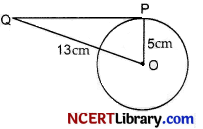
So, △POQ is right angled at P.
By Pythagoras theorem OQ2 = PQ2 + PO2
⇒ (13)2 = (PQ)2 + (5)2
⇒ 169 – 25 = (PQ)2
⇒ 144 = PQ2
⇒ PQ = √144
= 12 cm
Question 5.
Find the length of ST, if △PQR ~ △PST:
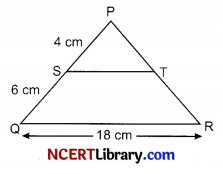
(a) 9 cm
(b) 10 cm
(c) 7.2 cm
(d) 7.4 cm
Answer:
(c) 7.2 cm
Explanation: Given: △PQR ~ △PST
Using SS similarity criterion, \(\frac { PQ }{ PS }\) = \(\frac { QR }{ ST }\)
From the figure, \(\frac { 10 }{ 4 }\) = \(\frac { 18 }{ ST }\)
10 × ST = 4 × 18
ST = \(\frac { 72 }{ 10 }\) = 7.2 cm
Question 6.
Write the value of cot2 θ – \(\frac{1}{\sin ^2 \theta}\):
(a) – 1
(b) 1
(c) 0
(d) None of these
Answer:
(a) – 1
Explanation: Given, cot2 θ – \(\frac{1}{\sin ^2 \theta}\)
⇒ cot2 θ – cosec2 θ (∵ cosec θ = \(\frac { 1 }{ sin θ }\))
⇒ – (cosec2 θ – cot2 θ) (∵ cosec2 θ – cot2 θ = 1)
⇒ – 1
![]()
Question 7.
The angle of elevation of the top of a lighthouse 60 m high, from two points on the ground on its opposite sides are 45° and 60°. What is the distance between these two points?
(a) 84.64 m
(b) 80.20
(c) 49.64
(d) 94.64 m
Answer:
(d) 94.64 m
Explanation: Given, in △ABC
tan 45° = \(\frac { BC }{ AC }\)
1 = \(\frac { 60 }{ AC }\)
AC = 60 m …(i)
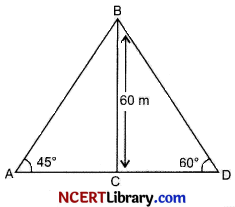
In △BCD, tan 60° = \(\frac { BC }{ AC }\)
√3 = \(\frac { 60 }{ CD }\)
CD = \(\frac { 60 }{ √3 }\)
= \(\frac{60 \sqrt{3}}{3}\)
= 20√3
= 20 × 1.732
= 34.64 cm
∴ Distance between two points AD = AC + AD
= 60 + 34.64
= 94.64 m
Question 8.
A card is drawn from a well-shuffled deck of 52 playing cards. The probability that the card will not be an ace is:
(a) \(\frac { 1 }{ 13 }\)
(b) \(\frac { 1 }{ 4 }\)
(c) \(\frac { 12 }{ 13 }\)
(d) \(\frac { 3 }{ 4 }\)
Answer:
(c) \(\frac { 12 }{ 13 }\)
Explanation: Total number of possible outcomes = 52
Number of aces in the pack = 4
Thus, the probability of not drawing an ace
∴ P(E) = \(\frac { 52 – 4 }{ 52 }\) = \(\frac { 48 }{ 52 }\) = \(\frac { 12 }{ 13 }\)
Question 9.
A sector is cut from a circle of 21 cm diameter. If the angle is 150° then what will be its area?
(a) 134.20 cm2
(b) 100 cm2
(c) 144.38 cm2
(d) None of these
Answer:
(c) 144.38 cm2
Explanation: Given, Diameter of circle = 21 cm
Radius of circle = \(\frac { 21 }{ 2 }\) cm
Angle of sector = 150°
Area of sector = \(\frac { θ }{ 360 }\) × πr²
= \(\frac { 150 }{ 360 }\) × \(\frac { 22 }{ 77 }\) × \(\frac { 21 }{ 2 }\) × \(\frac { 21 }{ 2 }\)
= 144.38 cm2
Question 10.
Two cubes each of 10 cm edge are joined end to end then what will be the surface area of the resulting cuboid?
(a) 100 cm2
(b) 10000 cm2
(c) 500 cm2
(d) 1000 cm2
Answer:
(d) 1000 cm2
Explanation: Length of resulting cuboid = 20 cm
Breadth of resulting cuboid = 10 cm
Height of resulting cuboid = 10 cm
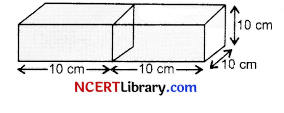
Surface area of cuboid = 2(lb + bh + hl)
= 2(20 × 10 + 10 × 10 + 20 × 10)
= 2 [200 + 100 + 200]
= 2 × 500 = 1000 cm2
Question 11.
When the equation ax2 + bx + c = 0 said to be quadratic equation?
(a) b ≠ 0
(b) a ≠ 0
(c) a = 0
(d) None of these
Answer:
(b) a ≠ 0
Explanation: Equation ax2 + bx + c = 0 is said to be quadratic when a ≠ 0.
Question 12.
Write maximum value of \(\frac { 1 }{ cosec θ }\):
(a) \(\frac { 1 }{ 2 }\)
(b) √2
(c) 1
(d) None of these
Answer:
(c) 1
Explanation:
Maximum value of \(\frac { 1 }{ cosec θ }\) = sin θ = 1, when θ = 90°
Question 13.
If cos4 θ = sin4 θ = \(\frac { 2 }{ 3 }\), then the value of 1 – 2 sin2 θ is:
(a) 0
(b) \(\frac { 2 }{ 3 }\)
(c) \(\frac { 1 }{ 3 }\)
(d) \(\frac { 4 }{ 3 }\)
Answer:
(b) \(\frac { 2 }{ 3 }\)
Explanation:
cos4 θ – sin4 θ = \(\frac { 2 }{ 3 }\)
⇒ (cos2 θ)2 – (sin2 θ)2 = \(\frac { 2 }{ 3 }\)
⇒ (cos2 θ + sin2 θ) (cos2 θ – sin2 θ) = \(\frac { 2 }{ 3 }\)
⇒ cos2 θ – sin2 θ = \(\frac { 2 }{ 3 }\) (∵sin2 θ + cos2 θ = 1)
⇒ 1 – sin2 θ – sin2 θ = \(\frac { 2 }{ 3 }\) (∵cos2 θ = 1 – sin2 θ)
1 – 2 sin2 θ = \(\frac { 2 }{ 3 }\)
![]()
Question 14.
How many real zeroes does the polynomial x4 – 1 has?
(a) 3
(b) 4
(c) 1
(d) 2
Answer:
(d) 2
Explanation:
Given polynomials is x4 – 1
⇒ x4 – 1 = (x2 – 1) (x2 + 1) [∵a2 – b2 = (a – b)(a + b)]
⇒ x4 – 1 = (x – 1)(x + 1)(x2 + 1)
So, x4 – 1 has two real zeroes.
Question 15.
The H.C.F. (a, b) = 2 and L.C.M. (a, b) = 27. what is the value a × b?
(a) 44
(b) 54
(c) 56
(d) 68
Answer:
(b) 54
Explanation:
a × b = H.C.F. × L.C.M.
= 2 × 27
= 54.
Question 16.
If tn = n(n + 3), then difference of its 5th term and 2nd term is:
(a) 20
(b) 30
(c) – 30
(d) 10
Answer:
(b) 30
Explanation:
tn = n(n + 3)
∴ t5 = 5(5 + 3) = 40
∴ t2 = 2(2 + 3) = 10
∴ t5 – t2 = 40 – 10 = 30
Question 17.
If π is taken as \(\frac { 22 }{ 7 }\), the distance (in metres) covered by a wheel of diameter 35 cm, in one revolution is:
(a) 2.2
(b) 1.1
(c) 9.625
(d) 96.25
Answer:
(b) 1.1
Explanation:
Given, diameter = 35 cm
Now, one revolution = circumference
= πd = \(\frac { 22 × 35 }{ 7 }\)
= 110 cm
= 1.1 m.
Question 18.
A rectangular sheet of paper 40 cm × 22 cm is rolled to form a hollow cylinder of height 40 cm. The radius of the cylinder (in cm) is:
(a) 3.5
(b) 5.3
(c) 2.5
(d) 5
Answer:
(a) 3.5
Explanation: Given, Area of the sheet of paper = (40 × 22) cm2
Height of the cylinder = 40 cm
Let r be the radius of the cylinder.
Now, curved surface area of the cylinder = 2πrh
∵ Area of rectangular sheet is equal to curved surface area of cylinder.
∴ 2\(\left(\frac{22}{7}\right)\)40r = 40 × 22
⇒ 2\(\left(\frac{1}{7}\right)\)r = 1 × 1
⇒ r = \(\frac { 7 }{ 2 }\) cm = 3.5 cm
Question 19.
DIRECTION: In the question number 19 and 20, a statement of assertion (A) is followed by a statement of Reason (R).
Choose the correct option
(a) Both assertion (A) and reason (R) are true and reason (R) is the correct explanation of assertion (A)
(b) Both assertion (A) and reason (R) are true and reason (R) is not the correct explanation of assertion (A)
(c) Assertion (A) is true but reason (R) is false.
(d) Assertion (A) is false but reason (R) is true.
Statement A (Assertion): The area enclosed by a chord and the major arc is major segment. Statement R (Reason): If a circle is divided into three equal arcs, then each is a major arc.
Answer:
(c) Assertion (A) is true but reason (R) is false.
Explanation: For assertion, the area enclosed by a sector is proportional to the arc length of the sector.
So, A = \(\frac { RL }{ 2 }\), A = area, R= radius and L = arc length
Hence, the resulting enclosed area is a major segment if it is a major arc.
So assertion is true.
For reason,
We basically denote an arc as a major arc when it is greater than the semicircle and if we divide a circle into 3 arc each of it will be less than a semicircle so it is a minor arc.
Question 20.
Statement A (Assertion): A hemisphere of radius 7 cm is to be painted outside on the surface. The total cost of painting at it ₹ 5 per cm2 is ₹ 2300.
Statement R (Reason): The total surface area hemisphere is 3πr2.
Answer:
(d) Assertion is false but the reason is true.
Explanation:
Total surface area of the hemisphere is
πr2 + 2πr2 = 3πr2 = 3 × \(\frac { 22 }{ 7 }\) × 7 × 7
= 462 cm2
Cost of painting = 462 × 5 = ₹ 2310
So, assertion is false but reason is true.
Section – B
Question 21.
Find the LCM and HCF of 198 and 144 and verify LCM × HCM = product of two numbers.
Answer:
We have, 198 = 2 × 32 × 11
and 144 = 24 × 32
So, LCM(198,144) = 24 × 32 × 11 = 1584
and HCF (198,144) = 2 × 32 = 18
Now, LCM(198,144) × HCF (198,144) = 1584 × 18 = 28512
Also, Product of 198 and 144 = 28512
Thus, LCM (198,144) × HCF (198,144) = Product of 198 and 144.
![]()
Question 22.
Find whether the following system of equations is consistent or inconsistent:
\(\frac { 3 }{ 2 }\)x + \(\frac { 5 }{ 3 }\)y = 7 and 9x – 10y = 14.
Answer:
We have,
\(\frac { 3 }{ 2 }\)x + \(\frac { 5 }{ 3 }\)y – 7 = 0
and 9x – 10y – 14 = 0
Here, a1 = \(\frac { 3 }{ 2 }\), b1 = \(\frac { 5 }{ 3 }\), c1 = -7
a2 = 9, b2 = – 10, c2 = – 14
Thus, \(\frac{a_1}{a_2}\) = \(\frac { 3 }{ 2 × 9 }\) = \(\frac { 1 }{ 6 }\), \(\frac{b_1}{b_2}\) = \(\frac { 5 }{ 3 (-10)}\) = – \(\frac { 1 }{ 6 }\)
Since \(\frac{a_1}{a_2}\) ≠ \(\frac{b_1}{b_2}\)
So, given system of equations has unique solution and it is consistent.
Question 23.
Suppose we throw a die once.
(i) What is the probability of getting a number greater than 4?
(ii) What is the probability of getting a number less than or equal to 4?
Answer:
(i) Let E be the event of getting a number greater than 4.
So, favourable outcomes of event E = {5, 6}
.’. n(E) = 2
⇒ Total number of outcomes, n(S) = 6
So, P(E) = \(\frac{n(\mathrm{E})}{n(\mathrm{~S})}\)
= \(\frac { 2 }{ 6 }\) = \(\frac { 1 }{ 3 }\)
(ii) Let F be the event of getting a number less than or equal to 4.
Then clearly, P(E) + P(F) = 1
⇒ P(F) = 1 – P(E)
= 1 – \(\frac { 1 }{ 3 }\) = \(\frac { 2 }{ 3 }\)
OR
There are 100 cards in a bag on which numbers from 1 to 100 are written. A card is taken out from the bag at random. Find the probability that the number on the selected card (i) is divisible by 9 and is a perfect square (ii) is a prime number greater than 80.
Number of possible outcomes = 100
(i) Let E1 be the event of getting a number divisible by 9 and is a perfect square.
.’. Favourable outcomes = {9, 36,81}
⇒ n(E1) = 3
.’. P(E1) = \(\frac { 3 }{ 100 }\)
(ii) Let E2 be the event of getting a prime number greater than 80.
.’. Favourable outcomes = {83,89,97}
⇒ n(E1) = 3
.’. P(E2) = \(\frac { 3 }{ 100 }\)
Question 24.
Find the 15th term from the last term of the A.P. : 3, 8,13,…, 253.
OR
Find the sum of all multiples of 7 lying between 500 and 900.
Answer:
Given A.P. is 3,8,13,…, 253.
Here, a = 3,d = 8-3 = 5,l = 253
We know that, nth term from last =l – (n – l)d
.’. 15th term from last = 253 – (15 -1)5 = 253 – 70
⇒ = 183
OR
Multiples of 7 lying between 500 and 900 are
504, 511, 518, 525,…, 896
We observe that the above series is an A.P.
.’. a = 504, d = 7,an = 896
Now, we know that, an = a + (n – 1 )d
⇒ 896 = 504 + (n -1) 7
⇒ 392 = 7(n -1)
⇒ n – 1 = 56
⇒ n = 57
Thus,
S57 = \(\frac { 57 }{ 2 }\) [504 + 896] [∵ Sn = \(\frac { n }{ 2 }\) (a + l)]
= \(\frac { 57 }{ 2 }\) × 1400
= 57 × 700 = 39900
Question 25.
Find the coordinates of a point P, which lies on the line segment joining the points A(- 2, -2) and B(2, – 4) such that AP = \(\frac { 3 }{ 7 }\) AB.
Answer:
Given : A(- 2,2), B(2, – 4) and AP = \(\frac { 3 }{ 7 }\) AB

⇒ 7AP = 3AB = 3AP + 3BP
4AP = 3BP
⇒ \(\frac { AP }{ BP }\) = \(\frac { 3 }{ 4 }\)
Thus, AP : BP = 3 : 4
Let, the coordinates of P be (x,y)
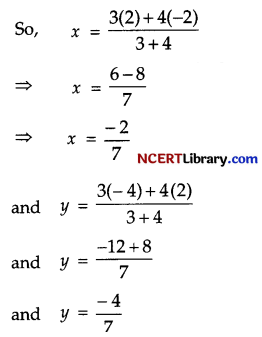
Hence, the coordinates of P are \(\left(\frac{-2}{7}, \frac{-4}{7}\right)\).
Section – C
Question 26.
One card is chosen from a well-shuffled deck of 52 cards. Calculate the probability of getting:
(i) A non-ace
(ii) Neither a king nor a jack.
Answer:
Total number of cards = 52
(i) Let, E be the event that chosen card is a non-ace.
Number of non-ace cards = 52 – 4 = 48
Thus, P(E) = \(\frac { Number of non-ace cards }{ Total number of cards }\)
= \(\frac { 48 }{ 52 }\)
= \(\frac { 12 }{ 13 }\)
(ii) Let, E be the event that chosen card is neither a king nor a jack.
Number of cards in which there is neither a king nor a jack = 52 – 8 = 44
Thus, P(E) = \(\frac { Number of cards neither a king nor a jack }{ Total number of cards }\)
= \(\frac { 44 }{ 52 }\)
= \(\frac { 11 }{ 13 }\)
![]()
Question 27.
Prove that √7 is an irrational number.
OR
The LCM of two numbers is 14 times their HCF. The sum of LCM and HCF is 750. If one number is 250, then find the other number.
Answer:
Let us assume, to the contrary that √7 is rational number. Then there exists co-prime positive integers p and q such that
√7 = \(\frac { p }{ q }\), q ≠ 0
⇒ p = √7q
On squaring both sides, p2 = 7q2 …(i)
⇒ 7 divides p2
⇒ 7 divides p
So, we have p = 7r, (where r is any integer)
Putting value of p – 7r in equation (i), we have,
49 r2 = 7q2
⇒ 7r2 – q2
⇒ 7 divides q2 so, 7 divides q.
So, 7 is a common factor of both p and q, which is a contradiction to our assumption so our assumption that √7 is rational is wrong.
Hence, √7 is an irrational number.
OR
Let HCF be H.
Then LCM = 14H
Now, sum of LCM and HCF is 750.
∴ 14H + H = 750
⇒ 15H = 750
⇒ H = \(\frac { 750 }{ 15 }\)
⇒ H = 50
∴ LCM = 14H = 14 × 50 = 700
We know that,
Product of LCM and HCF = Product of two numbers.
Then, 700 × 50 = 250 × y
⇒ y = \(\frac { 700 × 50 }{ 250 }\)
⇒ y = 140
Hence, the other number is 140.
Question 28.
If one zero of the polynomial 2x2 + 3x + λ is \(\frac { 1 }{ 2 }\), then find the value of λ and other zero.
Answer:
Let P(x) = 2x2 + 3x + λ
Its one Zero is \(\frac { 1 }{ 2 }\)
So, P (\(\frac { 1 }{ 2 }\)) = 0
⇒ 2(\(\frac { 1 }{ 2 }\))2 + 3(\(\frac { 1 }{ 2 }\)) + λ = 0
⇒ \(\frac { 1 }{ 2 }\) + \(\frac { 3 }{ 2 }\) + λ = 0
⇒ \(\frac { 4 }{ 2 }\) + λ = 0
⇒ 2 + λ = 0
⇒ λ = – 2
Let other zero be α. Then,
α + \(\frac { 1 }{ 2 }\) = \(\frac { -3 }{ 2 }\)
⇒ α = \(\frac { -3 }{ 2 }\) – \(\frac { 1 }{ 2 }\) = – 2
Hence, λ = – 2 and the other zero is -2.
Question 29.
How many numbers lie between 10 and 300, which when divided by 4 leaves a remainder 3?
Answer:
The first number greater than 10 which when divided by 4 leaves a remainder 3 is 11.
So, the next number will be 11 + 4 = 15
The other numbers will be 15 + 4 = 19,19 + 4 = 23……..
Thus, A.P. = 11, 15, 19, 23 …….
The last term of this A.P. will be 299.
We have to find n i.e., number of terms in the A.P.
We know, a + (n – 1 )d = an
⇒ 11 + (n – 1)4 = 299
⇒ 11 + 4n – 4 = 299
⇒ 7 + 4n = 299
⇒ 4n =299 – 7
⇒ 4n = 292
⇒ n = \(\frac { 292 }{ 4 }\)
⇒ n = 73
∴ 73 numbers lie between 10 and 300 which when divided by 4 leaves a remainder 3.
Question 30.
In the given figure, XP and XQ are two tangents to the circle with centre O drawn from an external point X. ARB is another tangent touching the circle at R. Prove that XA + AR = XB + BR.
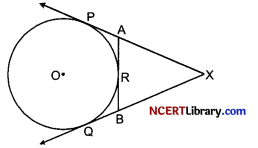
Answer:
As XP and XQ are two tangents from X, so
XP = XQ …(i)
Also, AP = AR [Tangents from the external point A] …(ii)
and BR = BQ [Tangents from the external point B] …(iii)
Now, XP = XQ [from (i)]
⇒ XA + AP = XB + BQ
⇒ XA + AR = XB + BR [from (ii) and (iii)]
Question 31.
Show that \(\frac{\sin \theta}{1-\tan \theta}\) – \(\frac{\cos \theta}{1-\cot \theta}\) = \(\frac{2 \sin \theta \cos \theta}{\cos \theta-\sin \theta}\)
OR
If sec θ = x + \(\frac { 1 }{ 4x }\), prove that sec θ + tan θ = 2x or \(\frac { 1 }{ 2x }\).
Answer:
Given:
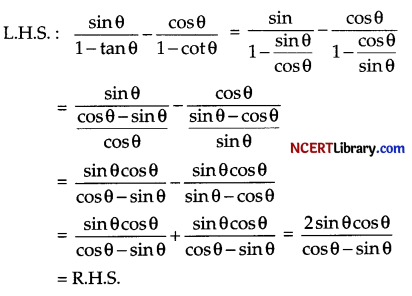
OR
Let sec θ + tan θ = λ
we know that sec2 θ – tan2 θ = 1
⇒ (sec θ + tan θ) (sec θ – tan θ) = 1
⇒ λ (sec θ – tan θ) = 1
⇒ sec θ – tan θ = \(\frac { 1 }{ λ }\)
On comparing, we get
λ = 2x or λ = \(\frac { 1 }{ 2x }\)
⇒ sec θ + tan θ = 2x or \(\frac { 1 }{ 2x }\)
Section – D
Question 32.
Two ships are there in the sea on either side of a lighthouse in such a way that the ships and the light house are in the same straight line. The angles of depression of two ships as observed from the top of the lighthouse are 60° and 45°. If the height of the lighthouse is 200 m, find the distance between the two ships. [Use √3 = 1.73]
Answer:
Given, the height of the lighthouse AC is 200 m. Let the distance of the first ship B from the light house berm and the distance of the second ship D from the lighthouse be y m.
Since, the angle of depression is 60° for the first ship.
In △ABC, we have
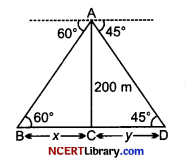
tan 60° = \(\frac { 200 }{ x }\)
⇒ √3 = \(\frac { 200 }{ x }\)
⇒ x = \(\frac { 200 }{ √3 }\)
Also, as the angle of depression is 45° with the second ship. In △ACD, we have
tan 45° = \(\frac { 200 }{ y }\)
⇒ 1 = \(\frac { 200 }{ y }\)
⇒ y = 200 m …(ii)
Thus, from equations (i) and (ii), the distance between the two ships is
x + y = \(\frac { 200 }{ √3 }\) + 200
= 200 (1 + \(\frac { 1 }{ √3 }\)) = 200 (\(\frac { √3 + 1 }{ √3 }\)
= 200(1.578)
= 315.6 m.
![]()
Question 33.
Solve the following system of equations graphically: 2x + 3y = 2 and x – 2y = 8.
OR
Check graphically whether the pair of equations 3x – 2y + 2 = 0 and \(\frac { 3 }{ 2 }\) x – y + 3 = 0 is consistent. Also find the coordinates of the points where the graphs of the equations meet the Y-axis.
Answer:
Let XOX’ and YOY’ be the X-axis and Y-axis respectively.
Now, 2x + 3y = 2 ⇒ 2x = 2 – 3y
⇒ x = \(\frac { 2 – 3y }{ 2 }\)
If y = 0, x = 1
If y = 2, x = – 2
If y = -2, x = 4
Therefore,
| x | -2 | 1 | 4 |
| y | 2 | 0 | -2 |
Thus, plotting the points P(- 2, 2), Q(1, 0) and R(4, – 2) on the graph paper, we get the graph of 2x + 3y = 2, which is represented by PR.
Now, x – 2 y = 8 ⇒ 2y = x – 8
⇒ y = \(\frac { x – 8 }{ 2 }\)
If x = 4, y = -2
If x = 6, y = – 1
If x = 8, y = 0
Therefore,
| x | 4 | 6 | 8 |
| y | -2 | -1 | 0 |
Thus, plotting the points R(4, – 2), S(6, – 1) and T(8, 0) on the graph paper, we get the graph of x – 2y = 8, which is represented by RT.
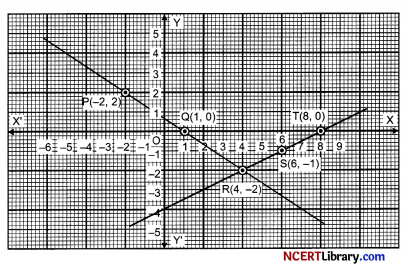
Hence, the solution is (4, – 2) as this is the point of intersection of both the lines.
OR
Let XOX’ and YOY’ be the X-axis and Y-axis respectively.
Now, 3x – 2y + 2 = 0 ⇒ 3x = 2y – 2
⇒ x = \(\frac { 2(y – 1) }{ 3 }\)
If y = – 2, x = – 2
If y = 1, x = 0
If y = 4, x = 2
Therefore,
| x | -2 | 0 | 2 |
| y | -2 | 1 | 4 |
Thus, plotting the points P(- 2, – 2), Q(0, 1) and R(2, 4) on the graph paper, we get the graph of 3x – 2y + 2 = 0, which is represented by PR.
Now, \(\frac { 3 }{ 2 }\) x – y + 3 = 0 ⇒ 3x – 2y + 6 = 0
⇒ y = \(\frac { 3(x + 2) }{ 2 }\)
Therefore,
| x | 0 | -2 | -4 |
| y | 3 | 0 | -3 |
Thus, plotting the points S(0, 3), T(- 2, 0) and U(- 4, – 3) on the graph paper, we get the graph of \(\frac { 3}{ 2 }\)– x – y + 3 = 0r which is represented by SU.
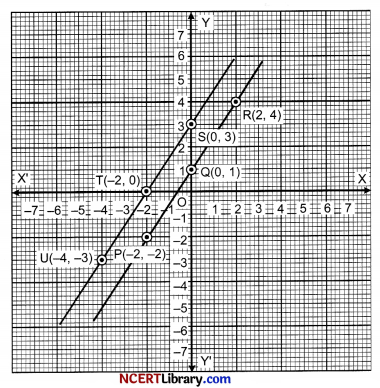
Since, the lines do not intersect each other at any point, so the pair of equations is inconsistent.
Also the lines representing the graphs of the equations, meet the Y-axis at points (0,1) and (0, 3).
Question 34.
The diagonals of a quadrilateral ABCD intersect each other at the point O such that \(\frac { AO }{ OC }\) = \(\frac { BO }{ OD }\) Show that ABCD is a trapezium.
OR
Through the mid-point M of the side CD of a parallelogram ABCD, the line BM is drawn intersecting AC at L and AD produced at E and AD = DE. Prove that EL = 2BL.
Answer:
Let EO || DC meet AD at E.
So, in △ADC, EO || DC
So, \(\frac { AO }{ OC }\) = \(\frac { AE }{ ED }\) [Thales’ theorem] …(i)
But \(\frac { AO }{ OC }\) = \(\frac { BO }{ OD }\) [Given] …(ii)
By (i) and (ii),
So, \(\frac { BO }{ OD }\) = \(\frac { AE }{ ED }\)
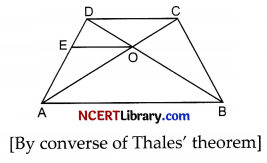
Hence, \(\frac { BO }{ OD }\) = \(\frac { AE }{ ED }\) and BO, OD, AE and ED are line segment of △DAB.
So, EO || AB [By converse of Thales’s theorem]
But EO || DC
Thus, AB || DC
As there are only two parallel sides in this quadrilateral, it is a trapezium.
OR
In △BMC and △EMD, we have
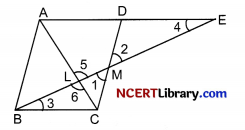
[Vertically opposite angles] [M being the mid-point of CD]
∠BCM = ∠EDM [Alternate angles]
Thus, △BMC ≅ △EMD [by ASA]
⇒ BC = DE
Again, BC = AD [opposite sides of the parallelogram ABCD]
∴ BC = AD = DE
So, AE = AD + DE = 2BC
Again, in △AEL and △CBL, ∠5 = ∠6 [vertically opposite angles]
∠3 = ∠4 [Alternate angles]
So, △AEL ~ △CBL
∴ \(\frac { EL }{ BL }\) = \(\frac { AE }{ BC }\) = \(\frac { 2BC }{ BC }\) = 2 [From (i)]
Thus, EL = 2BL.
Question 35.
The distribution below gives the marks of 100 students of a class :
| Marks | 0 – 5 | 5 – 10 | 10 – 15 | 15 – 20 | 20 -25 | 25 – 30 | 30 – 35 | 35 – 40 |
| No. of students | 4 | 6 | 10 | 10 | 25 | 22 | 18 | 5 |
Find the median marks of the given data.
Answer:
| Marks | No. of Students (fi) | Cumulative Frequency |
| 0 – 5 | 4 | 4 |
| 5 – 10 | 6 | 10 |
| 10 – 15 | 10 | 20 |
| 15 – 20 | 10 | 30 |
| 20 – 25 | 25 | 55 |
| 25 – 30 | 22 | 77 |
| 30 – 35 | 18 | 95 |
| 35 – 40 | 5 | 100 |
| N = Σfi = 100 |
Now, N = Σfi = 100
So, \(\frac { N }{ 2 }\) = 50
The cumulative frequency just above 50 is 55.
Hence, the median class is 20 – 25.
So, l = 20, h = 5, c = 30, f = 25 and \(\frac { N }{ 2 }\) = 50
Median = l + \(\frac{\frac{N}{2}-c}{f}\) × h = 20 + \(\frac{50-30}{25}\) × 5
= 20 + \(\frac { 100 }{ 2 }\)
= 20 + 4 = 24
Section – E
Question 36.
Students of class X are on visit of Sansad Bhawan. Teacher assign them the activity to observe and take some pictures to analyses the seating arrangement between various MP and speaker based on coordinate geometry. The staff tour guide explained various facts related to Math’s of Sansad Bhawan to the students, students were surprised when teacher ask them you need to apply coordinate geometry on the seating arrangement of MP’s and speaker.

Calculate the following refer to the above image and graph.
Answer the following questions :
(i) Refer to the points D and C, find the distance between the points C and D, if the coordinates of C is (2, – 2) and D is (- 2, – 3).
(ii) Refer to the points D, A and H, condition for collinearity of points DAH satisfy by relation.
OR
Refer to the points B and C, join BC. Mark a point P on BC and P divides the line segment B(1, 4) and C(2, – 2) such as \(\frac { BP }{ PC }\) = \(\frac { k }{ l }\), if P lies on the line x – y = – 8. Find the value of k.
(iii) Refer to the points F and E. Find the mid-point of the line segment joining by the points F(- 4, 3) and E(12, 3).
Answer:
(i) Distance between C(2, – 2) and D(- 2, – 3) is
D = \(\sqrt{(-2-2)^2+(-3+2)^2}\)
D = \(\sqrt{16+1}\)
D = √17
(ii) DA + AH = DH
OR
Given that P divides the line segment joining B(1, 4) and C(2, – 2) in the ratio k : 1 so the coordinate of P are \(\left(\frac{2 k+1}{k+1}, \frac{-2 k+4}{k+1}\right)\)

P\(\left(\frac{2 k+1}{k+1}, \frac{-2 k+4}{k+1}\right)\) lies on the line segment x – y = – 8
⇒ \(\left(\frac{2 k+1}{k+1}\right)\) – \(\left(\frac{-2 k+4}{k+1}\right)\) = – 8
⇒ 2k + 1 + 2k – 4 = – 8k – 8
⇒ 12k = -5
⇒ k = \(\frac { -5 }{ 12 }\)
(iii) Given point F(-4, 3) and E(12, 3).
Coordinates of mid-point are \(\left(\frac{-4+12}{2}, \frac{3+3}{2}\right)\) ⇒ (4, 3)
![]()
Question 37.
There is a circular park of radius 7 m and there is a pole at a distance of 24 m from the centre of the park.
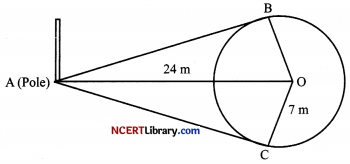
It is planned by the municipality to plant the trees along the line segments AB and AC.
Answer the following questions :
(i) If the length of AB is ‘x’m, then what is the length of AC?
(ii) Find the length of line segment AB.
OR
If the trees need to be planted on the tangents AB and AC, how much total distance is available for planting the trees?
(iii) If the consecutive distance between two trees is 20 cm, then find the number of trees can be planted on tangential line segments?
Answer:
(i) Since, AB and AC are tangents to a given circle. Then, lengths of tangents from an external point to a circle are equal in length.
.’. AB = AC = x
(ii) Since, AB ⊥ OB
Then, by Pythagoras theorem in △AOB,
AB2 = AO2 + OB2
= 242 + 72
= 576 + 49
AB2 = 625
AB = 25 m
OR
Total distance available = Length of 2 tangents
= AB + AC
= 2 AB (∵ AB = AC)
= 2\(\sqrt{\mathrm{DA}^2+\mathrm{OB}^2}\)
= 2 \(\sqrt{24^2 \times 7^2}\)
= 2 × 25 = 50 m
(iii) Total length of line segments = 50 m = 50 × 100 cm
.’. Number of trees can be planted = \(\frac { 50 × 100 }{ 20 }\) = 250 trees
Question 38.
Radha was very happy for her birthday. She got lots of presents on her birthday. Out of many birthday presents she liked the playing top the most. The shape of that top is like a cone which is surmounted by a hemisphere top as shown in the figure. The ‘Top’ was painted with dull colours, now Radha want to make it more bright by colouring it with different colours. The height of the top is 7 cm diameter of hemisphere is 5.6 cm.
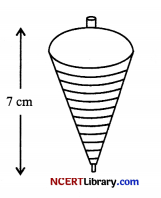
Answer the following questions :
(i) What is the surface area of hemispherical part, which is to be painted green?
(ii) If conical part need to be coloured bright orange. How much area need to be painted? (approx.)
(iii) Find the ratio of the height of the cone and hemispherical portion.
OR
What is the total cost of painting? If its cost ₹ 0.05 for 1 cm2?
Answer:
(i) Curved surface area of hemisphere = 2πr2
